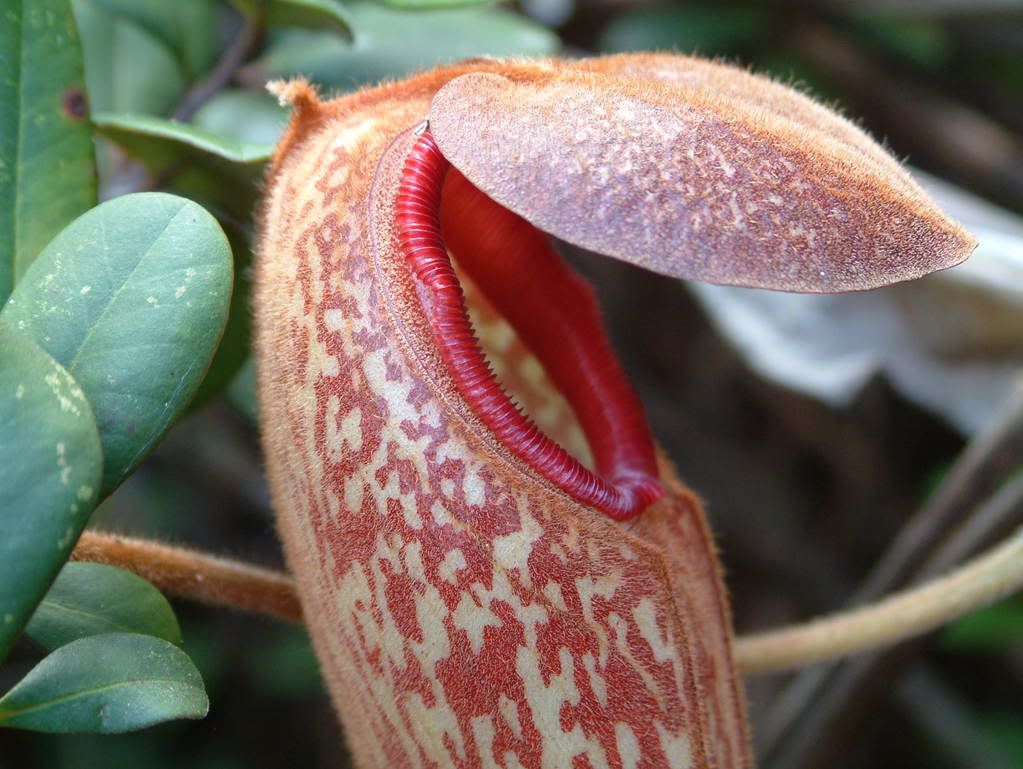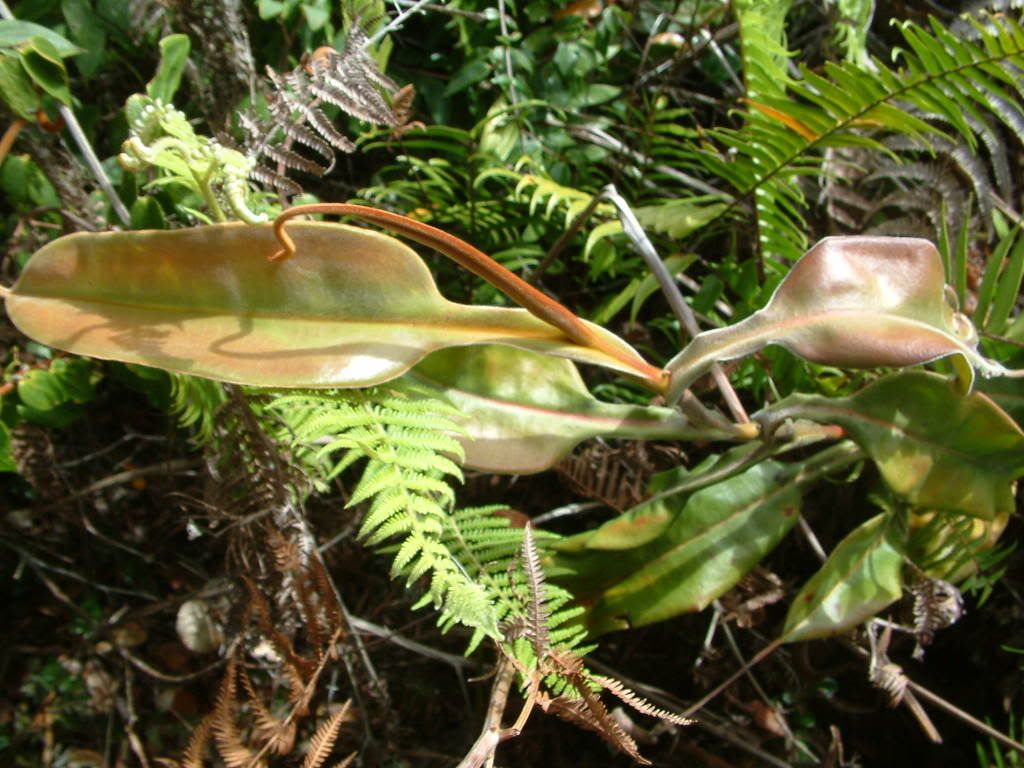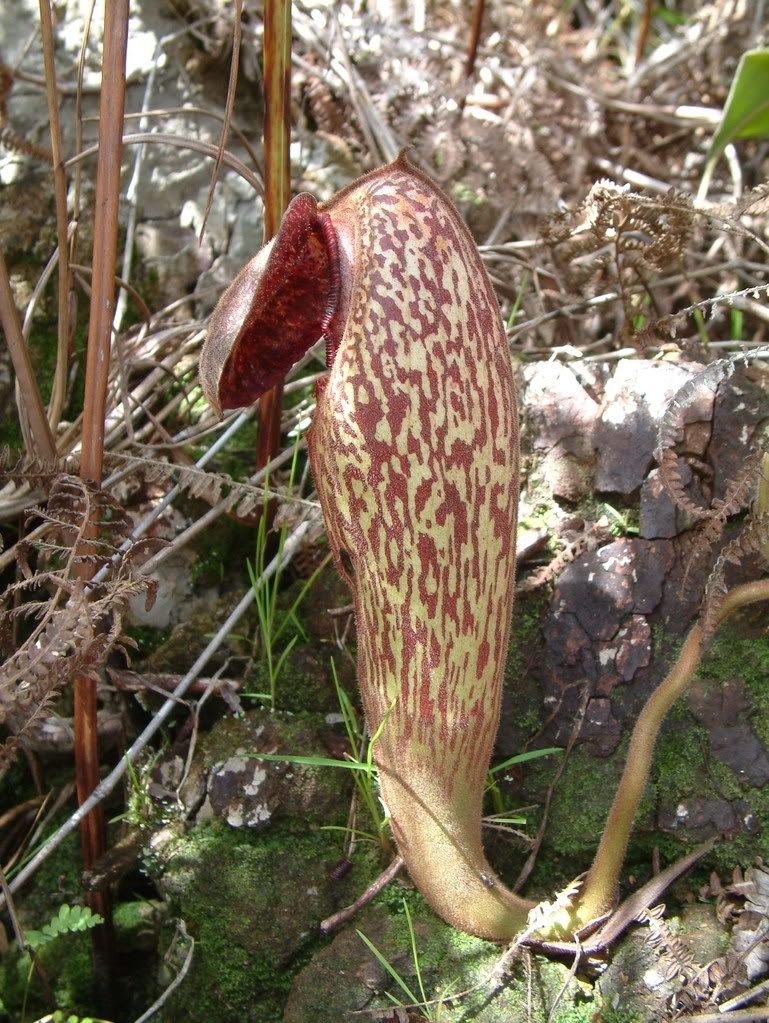|
|
Post by sockhom on Apr 23, 2008 10:11:45 GMT -10
Wooooooow  !! You made my day! Many many thanks!! Was the trip dangerous? François. |
|
|
|
Post by capslock on Apr 23, 2008 10:55:41 GMT -10
Really, really nice photos. Thanks for posting them!
Max
|
|
|
|
Post by rainforest on Apr 23, 2008 11:11:21 GMT -10
Congratulations Longor!
You found it! Interesting plant associations growing with klossii. From what it appears, rhododendrons, hoyas and erisotemmas with some ferns and other plants. One with palmate venetian looks like so many hoyas, but leave alternate, well perhaps something else.
Klossii appears to be somewhat stemmier and stiff rather than really vine-like. I look forward to the observations of the explorer to see what sort of conditions these plants favor. Previously I assumed more volcanic substrate, but the other flora appears to be more humus growing than lithophytic.
M
|
|
|
|
Post by longor on Apr 23, 2008 15:19:57 GMT -10
Thanks Guys,
Hi Francois, we were never under any direct threat in the trip, although the area is traditionally a Red zone due to past (present?) rebel activities. there have been skirmishes between the Indonesian Defence Force (TNI) and the rebels in the past, but there hasn't been any lately. Further, the area is known for illegal gold mining, so there is always tension when gold is around.
At the town closest to the location we stayed at the local Chief's house, and he arranged guides/guards for us, which accompany us during our search.
i think it is quite difficult for foreigners to enter that area, it is even hard for us, but we bypass security by taking an alternate route. Although i believe our presence there is known and watch by the intelligence there. there were lots of suspecious eyes, and friendly curious eyes as well.
|
|
|
|
Post by longor on Apr 23, 2008 15:41:10 GMT -10
Thanks Michael, its nice to be greeted by familiar "faces". I didn't take much notice in details of the plants growing in the habitat. There is sphagnum, utrics, antpalnt, and as usual various forms of terrestrial orchids, along with those you have mentioned. Hopefully Suska can follow the post with more detailed photos of Klossii and the surrounding plants. maxima was in such abundance it wasnt funny, at one point, its start to annoy us like weed!, its just max after max, with no sign of Klossii. Mind you, its a cute species, miniature form, very colourful, but that was not the reason we flew in there for. this is what i find interesting about Klossii habitat  the soil, it grows on gray clay!, despite of sphagnum and more wet area it prefers the dryer more open area. It grows thick root system into the clay. We thought that it would grow on the usual ultramafic red soil, but it was not to be. the area is not as cold as I thought, despite of elevation. during the day, its just as hot as any lowland condition that I have encountered. Although it drops substantially during the early hours of the morning (3-6 am). I notice the drop as i reached for my sleeping bag during the early hours. unfortunately the area that we went to is severly threatened, we only located 4 mature plants, fortunately with male and female, but the area is destined to be cleared. the surrounding Klossii habitat is no more, its the last remaining pocket in the area  . another thing that we notice, is that Klossii are being choked by the maxima around it, while maxima flowers all the time, we noticed that Klossii only send flower stalk when it gets ridiculously large, almost tree like. so it takes a long time before they can reproduce. Further, they are not a prolific flowerer, on average its about 15 leafs growth before each flower stalk. on the female plant that we saw, it was up to its tenth leaves from the last flower stalk, i'm not sure it can make it before the area is cleared. it is strange that there were not an abundance of seedlings which usually surround a female plant. it also seems that it does not like the wet sphagnum areas around it as well. the most striking aspect of Klossii is the size, its like that guy who went to liluput is. it is huge compared to the surrounding maxima population. the largest pitcher we saw was 30cm, and its consistently produce pitchers in the 20's cm mark.  the plant is very robust and hairy. it is covered by a very smooth velvet of hairs which gave it a fuzzy look. the fluid is watery and taste sour, its refreshing though  here is a close up look  without the pitchers Klossii is just a large hairy maxima  another interesting point about this plant is that on some pitchers, the lid covers the entire opening, it strike us as very strange as why would an upper pitcher prevents entry of prey? after closer observations, it was clear that the main prey was small black ants which climb the pitcher, gorge themselves on the the nectar underneath the lid then in a drunken state fall to their watery grave.  it seems that nepenthes with watery fluid focus on catching non flying insects, whilst those with stickier thicker fluid focuses on flying insects. it is interesting though, that the larger exagerated pitchers of Klossii catches ants, while the miniature pitcher of maxima, catches flying insects with their sticky fluid. |
|
|
|
Post by longor on Apr 23, 2008 15:55:54 GMT -10
i'm sure the area that we went to was not the only Klossii habitat, it was just the easiest one to get to as it is being push into destruction by population growth. The chief didn't recommend us to spend too long there and snoop around. people will get curious, and he was concern for our safety. So we let common sense ruled over pure utter lusting for this magnificent species. I think if someone attempts the original Woolastone expedition they will find more Klossii. word of warning though, Papua is very-very expensive, especially if you go deeper into the heartland.
you just have too look hard, as sometimes a species would grow on very specific habitat, if you move just a few hundred meters you see no sign of it. this was the case here, we split up, spent a whole day
criss-crossing what we though was the habitat only to return with frowns on our faces.
p.s.
I would like to say thanks to friends who have gave me clues and hints, provided text and literature over the years, any have provided many other forms of help. I'm sure being the humble gentlements that they are, they wish to remain anonymous. And off course there are no better place to share the photos and stories than among friends as well.
|
|
|
|
Post by longor on Apr 23, 2008 17:18:00 GMT -10
"waiting to ambush its prey"  |
|
|
|
Post by twoton on Apr 23, 2008 18:31:45 GMT -10
Thanks very much, longor!
I didn't realize this is such a peculiar species. After looking at the first ten pix or so, I was going to ask "were there no lowers?"....until I saw the last pix!
Learned something new today....
|
|
|
|
Post by longor on Apr 23, 2008 19:19:41 GMT -10
Thanks Twoton,
i've actually posted the lowers on the first page, forgot to label them. its a lot like Aristo, no really distinguishable lowers. the last photo i think is misleading, its an upper/intermediate which just happens to reach an elevated section of the soil.
cheers
|
|
|
|
Post by longor on Apr 23, 2008 19:33:55 GMT -10
N.Aristolochioides for comparison  |
|
|
|
Post by longor on Apr 23, 2008 19:46:49 GMT -10
|
|
|
|
Post by giruvegan on Apr 23, 2008 19:47:43 GMT -10
Were you guys able to collect seeds? It would be wonderful to get this into cultivation for preservation.
|
|
|
|
Post by longor on Apr 23, 2008 20:20:52 GMT -10
no seeds unfortunately, its damn hard to get the timing right.
|
|
|
|
Post by lamwn on Apr 24, 2008 2:32:26 GMT -10
Hi Longor,
thanks for the great pics! first time seeing so many amazing pics of this rare species.
What was the elevation at which you found these plants?
Its strange to see the veitchii leaf-arrangement pattern on the vines in the last pic...
thanks
|
|
|
|
Post by longor on Apr 24, 2008 2:42:24 GMT -10
thanks Lamwn, the funny thing is after seeing all different forms of maxima, they resemble a lot of other neps, whilst in Sulawesi i saw HL maxima with pitchers with wide persitome resembling Veitchii, what kind of a species with elevation range from 0-2900m? sometime i wonder if maxima is the mother of all species, or maybe its a super species that can tolerate any weather condition  plants were seen above 1500m |
|